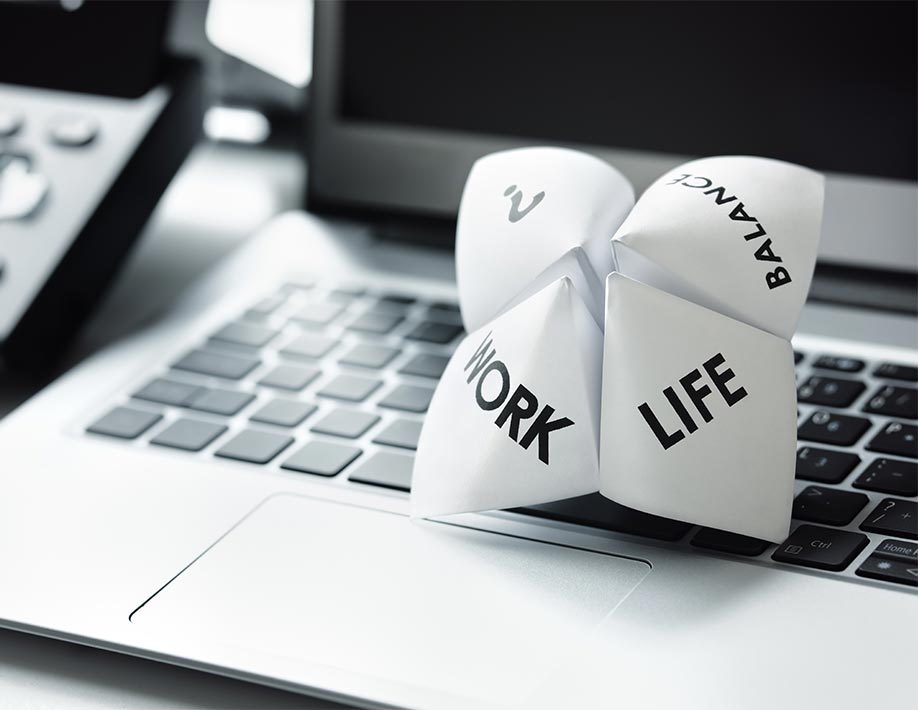Experiencing work-life balance can feel like an impossible task... for individuals and businesses alike. But we're here to spill the beans about how you, and your people, can truly attain it.
When it comes to the work-life balance discussion, one size does not fit all. What works for Ryan, a single man in his 20's in accounting, isn't going to work for Alexandra, a wife and mother of three, in marketing. Sarah's role requires frequent travel yet she has a sick parent she provides care for, not to mention she's engaged and planning a wedding. Kevin, in sales and on the phone most of the day, is an avid golfer and enjoys being on the green.
Really, how can a company truly help each of these individuals achieve an ideal work-life balance that will ensure they are appropriately engaged at work, while feeling fulfilled personally? It's a question and challenge that's top of mind in many companies.
According to Above Academy's 2020 Wellbeing Trends Survey Report, 36% of respondents cited work-life balance as one of their top 3 most important wellbeing topics to address in their strategy. Additionally, the topic tied for first place in conjunction with mental health.
Work and rest overlap
It's clear that businesses are keen to help people experience work-life balance. Common initiatives used in companies have included flexible working hours or work from home schemes. Since the COVID has entered the picture, work from home scenarios have become more common.
New concepts such as taking a "fake commute" in the morning and how to battle zoom fatigue are examples of the plethora of new tips to achieve work-life balance, when work and life are happening in the same location.
For those going into an office, onsite daycares, bike to work schemes, in-house fitness and relaxation room, and healthy snacks lunches are just a few of the many initiatives businesses offer to help their people find work-life balance.
Information overload - seems there's no turning back
What else is contributing to the challenge? We're trying to process too much information, do too much on a daily basis, in too little of time. For example, in 2011, Americans took in five times as much information every day at they did in 1986.3 No big deal right?
But how about this: the amount of information alone in a single edition of a newspaper today is equal to the amount of information that a person in Shakespeare's time would have received in their entire lifetime. A bit mind-boggling isn't it?
Add in family obligations, socializing, exercising, cooking, cleaning, and everything else related to "life" that isn't "work", and you start to see how a company just can't seem to have employees who are satisfied with their work-life balance.
Balancing energy - not time and tasks. Say what?!
Here's the deal though, and brace yourself now for the truth: the answer to today's business lifestyle, and overall lifestyles where demand exceeds capacity, is that modern work-life balance can be found by balancing energy and increasing personal energy capacity.
We'll let that sink in a moment for you. And repeat it again: solutions for finding work-life balance have traditionally focused on external factors such as implementing policies or creative scheduling, when the focus needs to be on framing work-life balance around an intrinsic factor. Something that's controlled on an individual basis.
Look at individual physical, mental and emotional elements of each person and teach them how to manage each of these elements effectively and view them as a source of energy.
Because that's the key here - finding out what can be done to manage and cultivate energy in your employees, and yourself, in a world where demand exceeds capacity.4 Make that happen for your people and you'll have cracked the work-life balance code.
- 1. https://www.shrm.org/resourcesandtools/hr-topics/benefits/pages/4-lessons-about-unlimitedvacation.aspx
- 2. https://hrdailyadvisor.blr.com/2020/02/10/the-pros-and-cons-of-unlimited-pto/
- 3. https://www.fastcompany.com/3051417/why-its-so-hard-to-pay-attention-explained-by-science
- 4. https://www.forbes.com/sites/alankohll/2020/01/02/new-study-reveals-top-workplace-wellbeinghabits-to-embrace-in-2020/#2730bd5e3526
